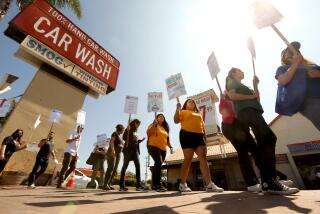Hopes Rise for Workers’ Comp Reform : Legislature: Special interests and partisanship have derailed previous efforts. This time, the political will appears to be there.
- Share via
SACRAMENTO — With Gov. Pete Wilson deliberately sitting on the sidelines, the Legislature is about to attempt final construction of a long-promised but elusive bipartisan reform of the embattled $12-billion workers’ compensation insurance system.
The state’s increasingly costly program for compensating employees who suffer work-related injuries has been singled out by employers as a major barrier to creating more jobs and restoring economic prosperity to California.
But unlike previous reform efforts wrecked by partisanship and special interest influence, expectations are running from modest to high that Sacramento this year can enact a credible overhaul of workers’ compensation.
If successful, California employers could count on substantial relief from insurance premiums that are among the highest in the nation. Likewise, injured workers would see major improvements in benefits, now among the lowest.
The combination of savings and benefit increases, though, would occur at the expense of a vast layer of economically and politically powerful middlemen, including attorneys for workers and employers, chiropractors, insurance companies, treating physicians, forensic doctors and vocational rehabilitation specialists.
Altogether, they could suffer losses of income variously calculated at anywhere from $1 billion to $3 billion. Under most apportionment schemes, savings would be split roughly in half between employers and disabled workers.
Although reform of the system is considered important in itself, the effort is imbued with political symbolism. Few issues in Sacramento have conveyed so clearly to the public the message of legislative gridlock as the arcane battle over workers’ compensation.
Futile attempts at reform--even though most everyone involved agreed change was needed--have highlighted the apparent wider failure of the Legislature and governor to deal effectively with many of the state’s most pressing problems.
So workers’ compensation is more than a test of whether one seemingly intractable problem can be solved. It has become a very public challenge to political leadership in the Capitol.
Looming over the governor and lawmakers are next year’s elections. Both need credible accomplishments in order to demonstrate to voters that they can overcome political stagnation.
Unlike previous years, combatants on virtually all sides of the issue agree that there is a new political will to improve the economic climate of California and erase the perception that the state is hostile to business.
“I think investors back in New York look at California in the same way that they view a Third World nation,” said Assemblyman Steve Peace (D-Chula Vista). “Is there a political stability that can be translated into an economic stability that is necessary for investment? Workers’ compensation is an issue symbolic of that bigger question.”
To that end, a Senate-Assembly conference committee is scheduled to start writing a compromise workers’ compensation reform package today. At a preliminary meeting last week, the committee told lobbyists and other witnesses to come prepared to propose major cost cuts.
In a move symbolizing the importance of the issue, Assembly Speaker Willie Brown (D-San Francisco) appointed himself to the negotiating committee. Other members include Assembly GOP leader Jim Brulte of Rancho Cucamonga, and workers’ compensation experts Peace, Sens. Bill Leonard of Big Bear, the Senate GOP caucus chairman; Patrick Johnston (D-Stockton) and Bill Lockyer (D-Hayward).
Brown said all the economic interests hit financially by a comprehensive reform will be angry, “but they’ll keep quiet because they’ll know it could be a lot worse.”
For his part, Wilson said recently that “I’d like to see us shave $2 billion off. . . . That’s the minimum I hope for.” Last year, he demanded a minimum savings of $1 billion to employers.
But in a sharp reversal of strategy of the past two years when he played a personal and aggressive role in clashing with Democrats, Wilson intends to monitor the reform legislation from the sidelines. His aides said the governor believes there is an “impetus for action” without his direct intervention.
“In our first two years here, there was resistance on the part of the Democrat majority to deal with the problem. (Our) only alternative was a heavy-handed one,” said Dan Schnur, the governor’s chief spokesman. “This year, there seems to be a willingness in both parties to address the problem realistically. (We) don’t need a bully pulpit anymore.”
Instead, the governor will depend heavily on an evenly split task force of top-level California business executives and labor leaders he appointed to monitor the reform package and advise him.
“I’m more optimistic than I was last year, but it’s not a done deal. It’s still a fight,” Leonard said.
He said the middlemen “winners” in the current system seem to agree that some sort of reform is likely to occur but want to deflect any loss of income to someone else.
“What we have is a powerful political force in favor of the status quo,” he said. “Each of these (middlemen) groups is saying: ‘We want change too, but what we do is beneficial to workers and/or employers and we’ve got to make sure that isn’t hurt.’ ”
Squads of lobbyists are busy drafting competing proposals, which they claim would reduce costs.
One vocational rehabilitation counselors group has recommended at least $315 million in cuts it says could be made without damaging programs aimed at returning disabled employees to work.
“We feel we have to come forward with these. If we don’t propose the appropriate cuts, others without an understanding of vocational rehabilitation will . . . (and) the system may collapse,” said Mark S. Dakos, president-elect of the California Professional Rehabilitation Assn.
No one is certain what the reform package will contain. However, broad outlines have been sketched in a dozen bills put before the conference committee in a series of overwhelmingly bipartisan votes.
Peace and Leonard agree that soaring medical treatment costs are ripe for reduction, probably through the intensified use of managed care organizations instead of more expensive fee-for-service health care providers.
Likewise, they foresee limitations being placed on costly litigation involving medical-legal evaluations that seek to set the degree of an injured worker’s disability; restrictions on eligibility for stress compensation, especially “retaliatory” claims filed by newly fired workers; limitations on vocational rehabilitation counseling services, and restricting insurance charges on employers.
At this point, no one is predicting the contents of a final reform package, but virtually all the participants agree that change is in store.
“Will it be radical? No,” Johnston said recently. “Can it be a sharp reduction in the costs that drive the system? I believe it can.”
Reforming Workers’ Compensation
The state workers’ compensation system is designed to pay benefits and medical costs to employees who suffer work-related injuries. It has been widely criticized for costing employers solutions as the Legislature attempts to reform the system:
MEDICAL COSTS
* THE PROBLEM: In California, employers are required to pay employees’ medical costs for work-related injuries and these costs have been rising. Medical care and health care account for about $5 billion in expenditures by the insurance system. The state currently regulates medical treatment fees, although physicians can charge higher rates if they are reasonable. The Legislature is seeking ways to hold down these costs.
* THE PROPOSALS: One item before the Legislature generally would prohibit physicians from charging more in workers’ compensation cases than the lowest sum charged for a similar non-work-related injury. Another provision is aimed at eliminating physician conflicts of interest by prohibiting the doctor from making treatment or medical-legal referrals to an entity in which the doctor has a financial interest. There is also a proposal to give employers expanded authority to route employees into managed care organizations for treatment of injuries and away from fee-for-service medicine, which tends to be more expensive.
MEDICAL-LEGAL REPORTS
* THE PROBLEM: In disputed cases between workers and employers, both sides obtain evaluations by forensic doctors in an attempt to establish the employee’s degree of disability for purposes of being compensated. The employer must pay for the evaluations, which can range from $1,000 to $1,400 each. The process may involve multiple doctors for each side and fees must be paid by the employer within 60 days of being billed.
* THE PROPOSALS: Various plans have been advanced to put the brakes on medical-legal costs, particularly those associated with so-called “mills” in Los Angeles County in which forensic doctors and applicant attorneys are suspected of pursuing phony claims. One remedy would limit medical-legal evaluations to one per side unless a workers’ compensation appeals judge ruled that additional reports are necessary. Another proposal would require physicians to sign their reports under penalty of perjury.
STRESS CLAIMS
THE PROBLEM: Workers’ claims for psychiatric or stress injuries are among the most controversial, with eligibility to qualify for compensation in California considered the most liberal in the nation. A worker must show by a preponderance of the evidence that actual employment events were responsible for at least 10% of the total cause of the stress injury.
* THE PROPOSALS: In varying degrees, competing proposals would make it more difficult for employees to claim compensation for psychiatric injuries by establishing a series of conditions. For instance, one would require that a sudden or extraordinary event outside the normal routine of employment must be the predominant cause of the injury. A more liberal standard would require the worker to demonstrate that workplace events were a substantial cause of the injury.
VOCATIONAL REHABILITATION
* THE PROBLEM: Established in 1975, vocational rehabilitation, which includes certain medical care, counseling and preparation of an injured employee to return to work, is one of the fastest-growing and costly elements of workers’ compensation. Advocates of vocational rehabilitation assert that without the program, disabled workers would turn to public welfare for their support. Critics contend that vocational rehabilitation costs are virtually open-ended and in need of tighter controls.
* THE PROPOSALS: Changes would include limiting vocational rehabilitation services to $10,000; restricting a worker to one plan that must be completed in 18 months; limiting payment of the employee’s current living allowance to 52 weeks, and requiring the workers to spend part of the proposed increase in permanent disability payments for vocational rehabilitation costs.
More to Read
Get the L.A. Times Politics newsletter
Deeply reported insights into legislation, politics and policy from Sacramento, Washington and beyond. In your inbox twice per week.
You may occasionally receive promotional content from the Los Angeles Times.










